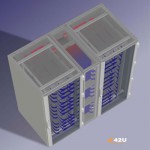
Compare the two main rack cooling approaches: Ambient Air & Liquid Cooling in Data Centers, Server Rooms, and Computer Rooms.

Compare the two main rack cooling approaches: Ambient Air & Liquid Cooling in Data Centers, Server Rooms, and Computer Rooms.
Beat the Heat – Effective Cooling Strategies for Today’s Data Centers and Server Rooms Uptime and Data Center Cooling are the main concerns for many Data Center managers. Excess heat in a server room adversely affects equipment performance, shortens its lifespan, and leads to a premature end of life for equipment. Keeping a server room

Utilize “Free Cooling” to reduce carbon emissions while lowering operational cost with Water-Side Economizers Limiting chiller operation-a practice dubbed “free cooling”-is intriguing, for “reducing the number of hours of chiller operation has a larger impact on lowering energy use in a facility than by selecting a more energy-efficient chiller” (Sorell, 2007). Users with an existing

Utilize “Free Air” to significantly reduce your operation costs by implementing Air-Side Economizers One of the most exciting and talked about best practices for data center efficiency is often labeled “free cooling”-the use of Air-side Economizers to dramatically reduce your HVAC related energy consumption and costs. Air-Side economizers have become a talking point, it seems,
Liquid Cooing: Powerful Cooling for Today’s Data Center Abstract Organizations are increasingly evaluating and implementing liquid cooling solutions to meet the heat challenges of blade servers and high-density computing. Liquid cooling solutions utilize air/liquid heat exchangers to provide quiet, uniform, effective cooling. Many IT professionals list cooling as a top issue in data center management,
Accenture recently reported on an event hosted by Sun Microsystems assessing four energy-efficient modular, scalable server rack cooling systems for data centers. During this “Chill-Off”, the four solutions were evaluated under a range of conditions reflecting different inlet air temperatures and server loads, and for the appropriate systems, elevated chilled water temperatures. The rack density
The Data Center Temperature Debate Though never directly articulated by any data center authority, the prevailing practice surrounding these critical facilities has often been “The colder, the better.” However, some leading server manufacturers and data center efficiency experts share the opinion that data centers can run far hotter than they do today without sacrificing uptime,
“Power and cooling is a pandemic in the world of the data center.” That was the message from Michael Bell, research vice president at Gartner Inc., speaking at the Gartner IT Infrastructure, Operations and Management Summit 2007 this week in Orlando. “By next year, about half the world’s data centers will be functionally obsolete due
Organizations are increasingly evaluating and implementing liquid cooling solutions to meet the heat challenges of blade servers and high-density computing. Liquid cooling solutions utilize air/liquid heat exchangers to provide quiet, uniform, effective cooling. Many IT professionals list cooling as a top issue in data center management, as excess heat and high temperatures can shorten equipment
What Are Liquid Cooling Units? Liquid Cooling Units are modular, temperature-neutral high-density cooling solutions that utilize air/water heat exchangers to provide uniform, effective cooling. One of the main benefits of self-contained liquid cooling units is that they result in little or no impact on the existing HVAC system.Liquid cooling units are mounted at the rack